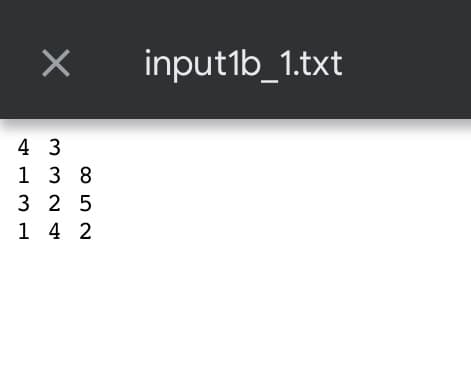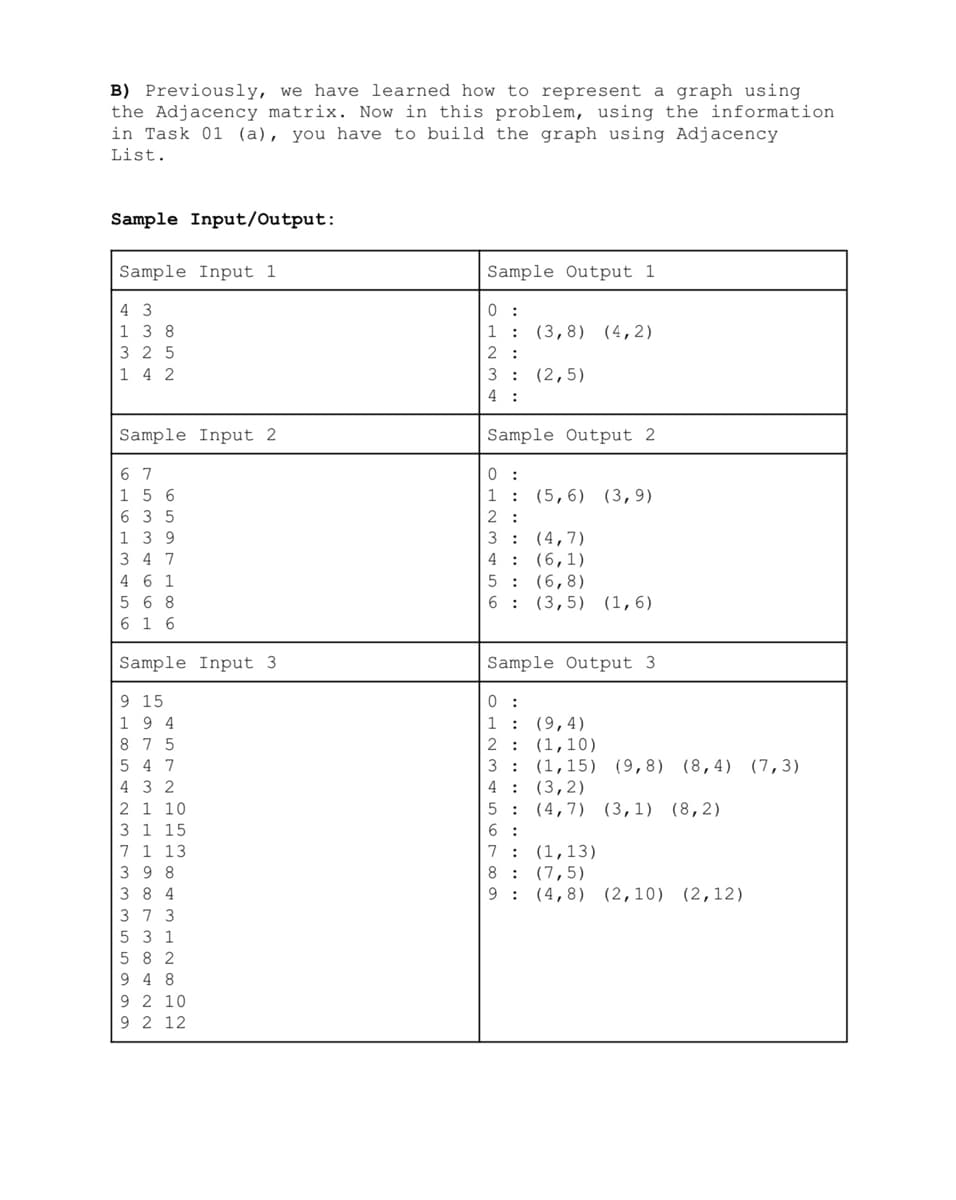B) Previously, we have learned how to represent a graph using the Adjacency matrix. Now in this problem, using the information in Task 01 (a), you have to build the graph using Adjacency List. Sample Input/Output: Sample Input 1 43 138 325 142 Sample Input 2 67 156 635 1 39 347 461 568 616 Sample Input 3 9 15 194 875 547 432 2 1 10 3 1 15 7 1 13 398 384 373 531 582 948 9 2 10 9 2 12 Sample Output 1 0: 1: (3,8) (4,2) 2: 3: (2,5) 4: Sample Output 2 0: 1: (5,6) (3,9) 2: 3: (4,7) 4 (6,1) 5: (6,8) 6 (3,5) (1,6) Sample Output 3 0: 1 2 3 4: 5 (4,7) (3,1) (8,2) 6: 7: (1,13) (7,5) (4,8) (2,10) (2,12) 8 9 (9,4) (1,10) (1,15) (9,8) (8,4) (7,3) (3,2)
B) Previously, we have learned how to represent a graph using the Adjacency matrix. Now in this problem, using the information in Task 01 (a), you have to build the graph using Adjacency List. Sample Input/Output: Sample Input 1 43 138 325 142 Sample Input 2 67 156 635 1 39 347 461 568 616 Sample Input 3 9 15 194 875 547 432 2 1 10 3 1 15 7 1 13 398 384 373 531 582 948 9 2 10 9 2 12 Sample Output 1 0: 1: (3,8) (4,2) 2: 3: (2,5) 4: Sample Output 2 0: 1: (5,6) (3,9) 2: 3: (4,7) 4 (6,1) 5: (6,8) 6 (3,5) (1,6) Sample Output 3 0: 1 2 3 4: 5 (4,7) (3,1) (8,2) 6: 7: (1,13) (7,5) (4,8) (2,10) (2,12) 8 9 (9,4) (1,10) (1,15) (9,8) (8,4) (7,3) (3,2)
C++ Programming: From Problem Analysis to Program Design
8th Edition
ISBN:9781337102087
Author:D. S. Malik
Publisher:D. S. Malik
Chapter8: Arrays And Strings
Section: Chapter Questions
Problem 24PE
Related questions
Question
Please use python and python file i/o to solve the problem. Create an input file input3_1.txt as shown below, solve the problem and print the output to output3_1.txt file as shown in the question.
Input:
The first line contains two integers N and M (1

Transcribed Image Text:X
4 3
1 3 8
325
1 4 2
input1b_1.txt

Transcribed Image Text:B) Previously, we have learned how to represent a graph using
the Adjacency matrix. Now in this problem, using the information
in Task 01 (a), you have to build the graph using Adjacency
List.
Sample Input/Output:
Sample Input 1
43
1 3 8
325
142
Sample Input 2.
6 7
156
635
1 39
347
461
568
616
Sample Input 3
9 15
194
875
5 47
432
2 1 10
3 1 15
7 1 13
398
384
373
5 3 1
582
948
9 2 10
9 2 12
Sample Output 1
0:
1: (3,8) (4,2)
2:
3: (2,5)
4:
Sample Output 2
0:
1 :
2:
3:
(5,6) (3,9)
(4,7)
4 (6,1)
5:
(6,8)
6 (3,5) (1,6)
Sample Output 3
0:
1
(9,4)
2
(1,10)
3
(1,15) (9,8) (8,4) (7,3)
4:
(3,2)
5 (4,7) (3, 1) (8,2)
6:
7
8
9
(1,13)
(7,5)
(4,8) (2, 10) (2,12)
Expert Solution
This question has been solved!
Explore an expertly crafted, step-by-step solution for a thorough understanding of key concepts.
Step by step
Solved in 3 steps with 3 images

Knowledge Booster
Learn more about
Need a deep-dive on the concept behind this application? Look no further. Learn more about this topic, computer-science and related others by exploring similar questions and additional content below.Recommended textbooks for you

C++ Programming: From Problem Analysis to Program…
Computer Science
ISBN:
9781337102087
Author:
D. S. Malik
Publisher:
Cengage Learning

C++ Programming: From Problem Analysis to Program…
Computer Science
ISBN:
9781337102087
Author:
D. S. Malik
Publisher:
Cengage Learning